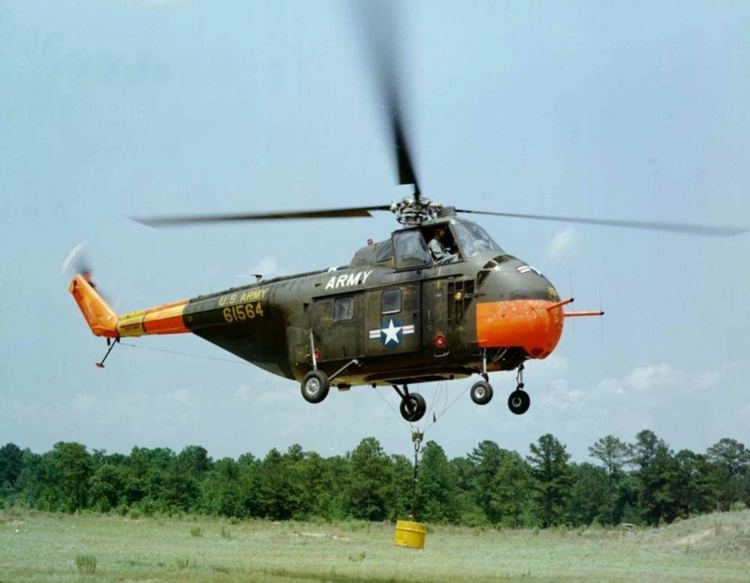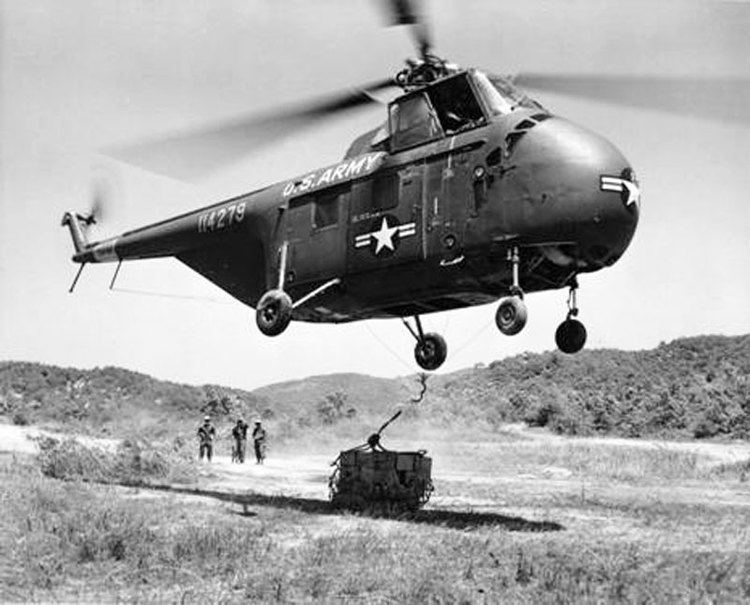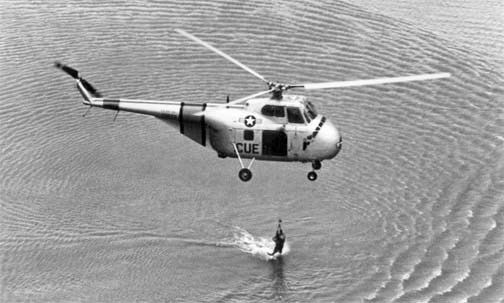Top speed 162 km/h Wingspan 16 m First flight November 10, 1949 | Length 19 m Introduced 1950 Manufacturer Sikorsky Aircraft | |
 | ||
The Sikorsky H-19 Chickasaw, (sold commercially under its Sikorsky model number, S-55) was a multi-purpose helicopter used by the United States Army and United States Air Force. It was also license-built by Westland Aircraft as the Westland Whirlwind in the United Kingdom. United States Navy and United States Coast Guard models were designated HO4S, while those of the U.S. Marine Corps were designated HRS. In 1962, the U.S. Navy, U.S. Coast Guard and U.S. Marine Corps versions were all redesignated as H-19s like their U.S. Army and U.S. Air Force counterparts.
Contents

Development

Development of the H-19 was initiated privately by Sikorsky without government sponsorship. The helicopter was initially designed as a testbed for several novel design concepts intended to provide greater load-carrying ability in combination with easy maintenance. Under the leadership of designer Edward F. Katzenberger, a mockup was designed and fabricated in less than one year.
The first customer was the United States Air Force, which ordered five YH-19 aircraft for evaluation; the YH-19's first flight was on 10 November 1949, less than a year after the program start date. This was followed by delivery of the first YH-19 to the U.S. Air Force on 16 April 1950 and delivery of the first HO4S-1 helicopter to the U. S. Navy on 31 August 1950. A U.S. Air Force YH-19 was sent to Korea for service trials in March 1951, where it was joined by a second YH-19 in September 1951. On 27 April 1951, the first HRS-1 was delivered to the U.S. Marine Corps, and on 2 May 1951, the first S-55 was delivered to Westland Aircraft.
1,281 of the helicopters were manufactured by Sikorsky in the United States. An additional 447 were manufactured by licensees of the helicopter including Westland Aircraft, the SNCASE in France and Mitsubishi in Japan.
The helicopter was widely exported, used by many other nations, including Portugal, Greece, Israel, Chile, South Africa, Denmark and Turkey.
In 1954 the Marines tested an idea to enhance lift in hot and high and/or heavily-loaded conditions by installing a rocket nozzle at the tip of each rotor blade with the fuel tank located in the center above the rotor blade hub. Enough fuel was provided for seven minutes of operation. Although tests of the system were considered successful, it was never adopted operationally.
Design
Major innovations implemented on the H-19 were the forward placement of the engine below the crew compartment and in front of the main cabin, the use of offset flapping hinges located nine inches (229 mm) from the center of the rotor, and the use of hydraulic servos for the main rotor controls. These features yielded an aircraft that was far more capable in a transport role than previous Sikorsky designs.
Locating the engine forward allowed the main cabin to be located essentially in line with the main rotor's rotational axis and close to the aircraft center of gravity, making it easier to maintain proper weight and balance under differing loading conditions. The impetus for this design choice was the recent rejection of the Sikorsky XHJS by the U.S. Navy in favor of the tandem rotor Piasecki HUP Retriever; the Navy had strongly objected to the necessity to use ballast in the cabin-forward XHJS to maintain proper weight and balance, prompting Sikorsky to seek single-rotor design alternatives that did not require this.
Another benefit of this engine location was ease of maintenance, as the engine could be readily accessed at ground level through dual clamshell-style doors; the entire engine could be changed in only two hours, and the radial engine was oriented backwards relative to a typical airplane installation, allowing more convenient access to engine accessories.
The offset flapping hinges and hydraulic servos gave more positive flight control under differing loading conditions, isolated the flight controls from vibration, and lessened control forces; the H-19 could be flown with only two fingers on the cyclic control.
The YH-19 prototypes featured a blunt aft fuselage and a single starboard-mounted horizontal tailplane with a small vertical fin at its outboard end. Initial production models added a large fillet-like fin behind the fuselage and under the tailboom, and the tailplane configuration was changed to an inverted "V" shape.
Early H-19 and HO4S variants were powered by a Pratt & Whitney R-1340-57 radial rated at 600 hp (472 kW) and used a centrifugal clutch that automatically engaged the main rotor when a preset engine speed was reached. However, the HO4S was deemed underpowered in U.S. Navy service with this powerplant, so the aircraft was re-engined with a 700 hp (522 kW) Wright R-1300-3 radial which the U.S. Navy found to be adequate in an air-sea rescue role; the H-19B, HO4S-3, HRS-3, and subsequent models would use this powerplant. The R-1300 models also used a single horizontal tailplane in place of the early inverted "V" style, and a new hydro-mechanical clutch gave smoother and more rapid rotor acceleration during clutch engagement and allowed the engine to be started and operated at any speed while disengaged from the transmission and rotors.
Early civilian and military S-55 models offered a folding 400 lb (181 kg) capacity hoist above the starboard main cabin door, while later models could be equipped with a more capable and reliable 600 lb (272 kg) capacity unit. Starting with the introduction of the S-55C in October 1956, the tailboom was inclined three degrees downward to provide more main rotor clearance during hard landings; models equipped with the inclined tail also used an 8 ft 9 in (2.67 m) tail rotor in place of the earlier 8 ft 8 in (2.64 m) unit.
Operational history
The H-19 Chickasaw holds the distinction of being the US Army's first true transport helicopter and, as such, played an important role in the initial formulation of Army doctrine regarding air mobility and the battlefield employment of troop-carrying helicopters. The H-19 underwent live service tests in the hands of the 6th Transportation Company, during the Korean War beginning in 1951 as an unarmed transport helicopter. Undergoing tests such as medical evacuation, tactical control and frontline cargo support, the helicopter succeeded admirably in surpassing the capabilities of the H-5 Dragonfly which had been used throughout the war by the Army.
The U.S. Air Force ordered 50 H-19A's for rescue duties in 1951. These aircraft were the primary rescue and medical evacuation helicopters for the USAF during the Korean War. The Air Force continued to use the H-19 through the 1960s, ultimately acquiring 270 of the H-19B model.
On 1 September 1953, Sabena used the S-55 to inaugurate the first commercial helicopter service in Europe, with routes between Rotterdam and Maastricht in the Netherlands and Cologne and Bonn in Germany.
France made aggressive use of helicopters in Algeria, both as troop transports and gunships, Piasecki/Vertol H-21 and Sud-built Sikorski H-34 helicopters rapidly displaced fixed-wing aircraft for the transport of paras and quick-reaction commando teams. In Indochina, a small number of Hiller H-23s and Sikorsky H-19s were available for casualty evacuation. In 1956, the French Air Force experimented with arming the H-19, then being superseded in service by the more capable Piasecki H-21 and Sikorsky H-34 helicopters. The H-19 was originally fitted with a 20-mm cannon, two rocket launchers, two 12.7-mm machine guns, and a 7.5-mm light machine gun firing from the cabin windows, but this load proved far too heavy, and even lightly armed H-19 gunships fitted with flexible machine guns for self-defense proved underpowered.
The H-19 was also used in the early days of the Vietnam War before being supplanted by the Sikorsky H-34 Choctaw, which was based on the H-19.
The H-19 left U.S. military service when the CH-19E was retired by U.S. Navy squadron HC-5 on 26 February 1969. Surplus H-19s were sold on the open market, and civil interest was sufficient that Sikorsky (and later Orlando Helicopter Airways) offered conversion kits allowing a military surplus H-19 to be commercially operated under a standard Federal Aviation Administration type certificate as an S-55B. Turboshaft conversions and a novel campervan-like "Heli-Camper" conversion—featuring a built-in mini-kitchen and sleeping accommodations for four—were also offered by aftermarket modification companies.
Variants
Later marks of Whirlwind were built under licence.
Aircraft on display
See Westland Whirlwind (helicopter) for examples of the British license-built S-55.
Specifications (H-19C)
Data from U.S. Army Aircraft Since 1947
General characteristics
Performance
